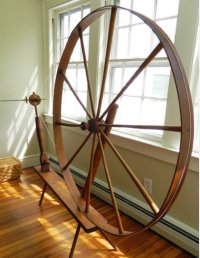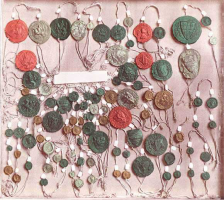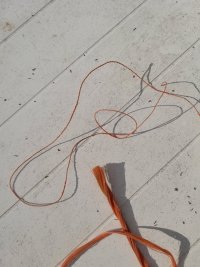I've been thinking of making a sampler - not sure what the finished object will look like - demonstrating as many different cord-making techniques as I can find. I thought it'd make a fun game thread!
Here are the rules:
#1 - Idiot Cord
Known in genteel knitting circles as 'I-Cord', you [knit four stitches](https://nimble-needles.com/stitches/how-to-knit-an-i-cord-for-beginners/) on a double pointed needle - slide it down to the end - pull the thread across the back and knit four more stitches - and by repeating this process, you will quickly make a length of cord.
> The i-Cord technique has been documented in a printed pattern as early as 1856. A book entitled The Finchley Manuals of Industry No IV. Plain Needle-Work calls this technique a "stay-lace" and offers a quick explanation of how to create this type of cording. In 1974, Elizabeth Zimmerman “rediscovered” this quick and easy way to create a lovely knit cord, which she dubbed the i-Cord (because, she believed it to be so simple an "idiot" could do it).
It is tubular & stretchy. Mine is made from cheap acrylic DK wool I had lying around, so it comes out quite chunky, but with smaller needles and a firmer, more textured textile (maybe bamboo?) I can see this would be very nice.
In knitting, it can be sewn on as a 3D decorative hem, used to make tassels on the end of scarves, or used in toys to make legs and antennae - or clothing ties.
Looking in my bag of cord, I find that several of them seem to be I-Cord, but very slender, and made from something smooth and plasticky.
Who's next? Share a technique!
Here are the rules:
- name & describe a technique to make some string
- rope, cord, or anything similar also acceptable.
- you must have used the technique yourself (no spamming from a big list of techniques)
- tell us something about it (does it stretch? is it sturdy? easy? fun?)
- Include photo, or links to photos, or links to tutorial
#1 - Idiot Cord
Known in genteel knitting circles as 'I-Cord', you [knit four stitches](https://nimble-needles.com/stitches/how-to-knit-an-i-cord-for-beginners/) on a double pointed needle - slide it down to the end - pull the thread across the back and knit four more stitches - and by repeating this process, you will quickly make a length of cord.
> The i-Cord technique has been documented in a printed pattern as early as 1856. A book entitled The Finchley Manuals of Industry No IV. Plain Needle-Work calls this technique a "stay-lace" and offers a quick explanation of how to create this type of cording. In 1974, Elizabeth Zimmerman “rediscovered” this quick and easy way to create a lovely knit cord, which she dubbed the i-Cord (because, she believed it to be so simple an "idiot" could do it).
It is tubular & stretchy. Mine is made from cheap acrylic DK wool I had lying around, so it comes out quite chunky, but with smaller needles and a firmer, more textured textile (maybe bamboo?) I can see this would be very nice.
In knitting, it can be sewn on as a 3D decorative hem, used to make tassels on the end of scarves, or used in toys to make legs and antennae - or clothing ties.
Looking in my bag of cord, I find that several of them seem to be I-Cord, but very slender, and made from something smooth and plasticky.
Who's next? Share a technique!



